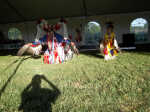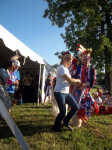Fancy Dancers wow crowds at FSNHS

Dressed in intricate, brightly-colored outfits and telling tales of how their dances came to be, the Connywerdy family -- members of the Oklahoma Fancy Dancers -- held rapt an audience of about 200 at Fort Scott National Historic Site.
The Fort on Saturday paid tribute to Native Americans with "The American Indian: Then and Now," featuring two demonstrations, presentations and two performances by the Fancy Dancers, which attracted some 500 spectators total.
The event coincided with the June 1-2 Good Ol' Days street festival.

The dancers are Caddo and Kiowa, but fancy dancing probably originated with the Ponca people, they said. Another possibility is that it came out of the Wild West shows.
"As time went on, fancy dance has developed into what you see today," said Kevin Connywerdy of Norman, Okla., who performed along with his wife Kricket Rhoads-Connywerdy and children Thaumi, 4, Sokobi, 7, and 9-year-old Angelyn.
The family are members of the Kiowa, Comanche and Caddo tribes.

Angelyn performed the shawl dance, which Kricket said started in the northern plains, explaining that a woman who had lost her husband and went mourning for a year. After that, her family said she should start living life again. She emerged and danced like a butterfly, so the dance Angelyn did is called the "Butterfly Dance."
When Kevin and his sons danced, they donned colorful outfits to help them stand out.
"The costumes are colorful because of (pow-wow) competitions," Kevin said.
Kevin Connywerdy performed the "Eagle Dance," -- complete with eagle feathers -- which came from the Pueblo people in Arizona. The eagle gets closest to the creator and helps the Native Americans' prayers get to him, said Connywerdy.
He also presented the hoop dance -- the hoop is sacred because it symbolizes the circle of life -- and led a social dance called a "two-step," which is one of the only times you'd see a man and woman dancing as a couple. The woman asks the man to dance and if the man refuses, he has to pay for the right not to.
Before starting her "Jingle Dress Dance," Rhoads-Connywerdy took some time to explain some of the story behind it.
The Caddos were a matriarchal society in which the women kept the dance beat with turtle shells on their leggings. They were also called shell shakers, Rhoads-Connywerdy said.
Plains tribes were patriarchal societies whose men kept the beat with drums.
Dressed in a "healing" or "jingle dress," Rhoads-Connywerdy said the cones on her outfit were made from tobacco can lids that show prayers are being sent up to God.
The Oklahoma Fancy Dancers were established in 1995. Kricket began fancy dancing when she was 18 and had a background in storytelling dance and ballet. Kevin was 12 when he began. "Our kids have been dancing since they could walk," Kricket said.
She is director of the Jacobson House Native Art Center at Norman, which offers classes in flute, basket weaving, beadwork and more. Together and separately, the family has traveled to the Netherlands, Japan, France, Germany, Iceland and Turkey. The Fancy Dancers as a whole have been to more than 30 countries.
Since Kricket began working there two years ago, the family doesn't travel as much as they used to. Kevin takes one to two overseas trips annually. "We probably go out of Oklahoma at least five times a year," Kricket said, adding she likes her family to see something unique to the area they're performing in.
Many people attended the Fort's programs because it was different. "I thought it was very informative. It's been very informative and entertaining," Fort Scott resident Donna Casner said. She attended the quilt presentation and was "very impressed."
Doug Altic, also of Fort Scott, twice attended the Fancy Dancers' performance with his 8-year-old daughter Abby. "It was very interesting, educational and entertaining, mostly," Altic said.
